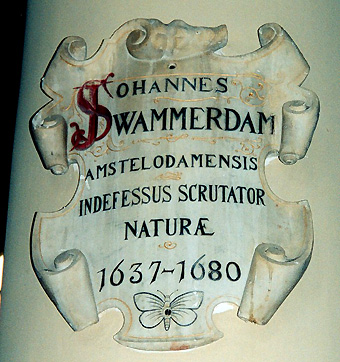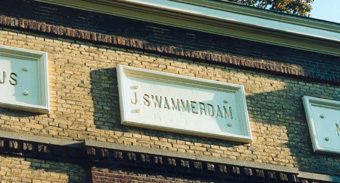 |
|
|
|||
| Swammerdam’s science His life and work Nerve function Muscles Bees and ants "The Bible of Nature" Amazing drawings Techniques and microscopy Preformationism Swammerdam’s life Birth Death A fake “portrait” Science in society Empiricism and religion Mysticism and modern science Illustrations and their meaning Swammerdam in culture Swammerdam's world Friends and contemporaries Contemporary accounts On-line resources Under construction: Discussions of Swammerdam’s work A bibliography of Swammerdam's works Contact |
Swammerdam died in what was apparently the house of his friend and main heir, Margarita Volckers, on the Weesperplein on the southern edge of Amsterdam. The region has since been redeveloped, and there are no traces of any 17th century houses. Four days later, on the evening of 21 February 1680, Swammerdam was buried in grave No. 8 of the Amsterdam Walloon Church ("Waalse Kerk") on the Walenpleintje, a small impasse off the Achterburgwal.  © M. Cobb All the graves in the church have long since been cleared, and the worn gravestones that once again form the floor of the church carry no trace of his name. However, on the bicentenary of Swammerdam's death, in 1880, a plaque to his memory was placed on a pillar in the church - apart from the organ, this is the only ornament in a very simple and elegant interior. Appropriately, there is a butterfly engraved on the memorial. The Latin text reads: "Jan Swammerdam, Amsterdamer, tireless investigator of nature".  © M. Cobb The church is not open all the time, but services are held on Sundays and concerts regularly take place there. The church was rebuilt in 1816, then restored first in 1891 then in 1991-2. For more information, click here. There are other memorials to Swammerdam in Amsterdam. For example, in the 19th century, his name was placed on the walls of Amsterdam Zoological museum, together with those of other great naturalists:  © M. Cobb More recently, Amsterdam University decided to set up a Swammerdam Institute for Life Sciences, in recognition of his important contribution to the history of biology. And Amsterdam town council named a street after Swammerdam, near streets named after his friends Blasius and Ruysch, as well as Boerhaave, who edited The Bible of Nature, and other contemporaries of Swammerdam such as Tulp, Hudde and Spinoza :  © Lonely Planet |